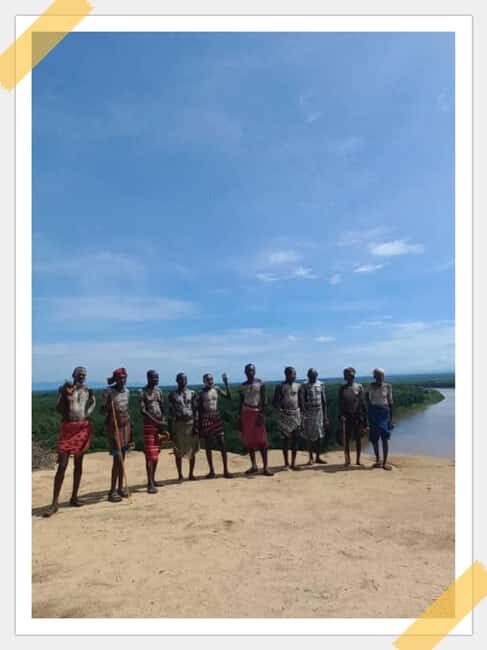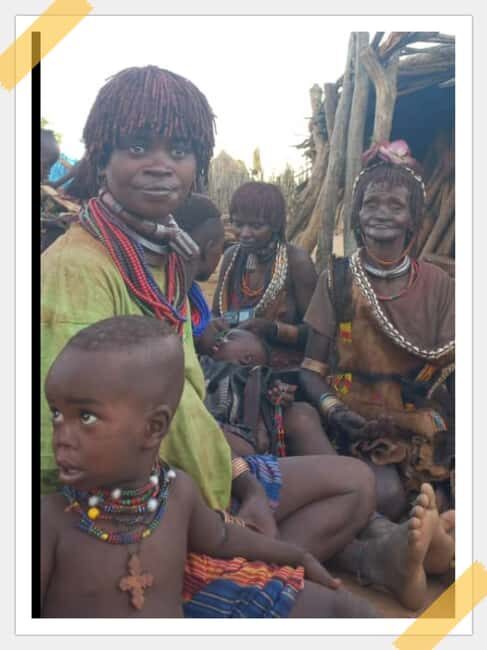If you’re craving an adventure that combines vibrant tribal cultures, astonishing natural scenery, and a taste of untouched Ethiopia, this 8-day South Omo Valley tour promises just that. We’ve seen this trip praised for its immersive encounters, expert guides, and stunning vistas, making it a standout experience for intrepid travelers.
What makes this journey compelling? First, the chance to cross the mighty Omo River in a traditional boat and visit the Dassanech tribe offers an authentic glimpse into life along Ethiopia’s most iconic river. Second, the surreal sight of the Mursi women with their large clay lip plates is unforgettable — a true bucket-list moment. Lastly, the visit to a UNESCO-registered village in Konso provides a rare opportunity to see well-preserved indigenous architecture and cultural practices.
That said, a potential consideration is the physically demanding nature of some stops, like visiting remote villages or walking through tribal areas. The tour’s schedule is packed, but it’s designed for those eager to explore Ethiopia’s most authentic and less-touristed regions. This adventure suits travelers who love cultural discovery, breathtaking landscapes, and are comfortable with moderate travel logistics.
Key Points
- Authentic Cultural Encounters: Meet tribes like the Dassanech, Mursi, and Kara in their traditional settings.
- UNESCO Heritage Sites: Visit one of the nine registered villages in Konso for a glimpse into ancient architecture.
- Natural Beauty: Experience boat trips on Lake Chamo and views of Lake Abiata.
- Expert Guides & Logistics: Knowledgeable local guides and all-inclusive pricing enhance your experience.
- Varied Activities: From tribal visits to markets, boat rides, and cultural ceremonies.
- Suitable for Curious Travelers: Designed for those eager for in-depth culture, with some physical activity involved.
An In-Depth Look at the 8-Day South Omo Valley Tour

Looking for more options in Omorate? We've reviewed plenty of other experiences.
Arrival in Addis Ababa and City Tour
Your journey begins in Ethiopia’s bustling capital, Addis Ababa. The Ethio Wildlife Tours team will meet you at the airport, making for a smooth start. After settling into your hotel, you get an introductory city tour — a chance to see some of Ethiopia’s political and cultural landmarks. This initial day helps acclimate you and sets the tone for the adventure ahead.
From Addis Ababa to Lake Awasa
On day two, you leave the city behind for a scenic drive to Lake Awasa, passing through Abyyata and Shala Lake Park. Expect lush landscapes and the gentle buzz of local life. Lake Awasa is known for its birdlife and scenic views, making it a restful stop before heading further south. Lunch at the lakeside hotel gives you a chance to soak in the natural surroundings.
Visiting Dorze Village and the Monkeys of Welayta Sodo
Day three is a highlight for many travelers. After breakfast, you visit a public park where you can observe colobus and vervet monkeys— a fun prelude to the main event: the Dorze village. Known for their remarkable bamboo houses and intricate weaving crafts, the Dorze people are masters of textiles and bamboo architecture. You’ll have the chance to see their colorful textiles and learn about their cotton farming traditions.
Reviews mention that guides are particularly knowledgeable here, explaining the significance of Dorze’s unique architecture and weaving techniques. The village visit offers great photo opportunities and insight into a resilient, centuries-old community.
More Great Tours NearbyFrom Arbaminch to Konso
The next day, a boat trip on Lake Chamo provides a striking view of local wildlife, including crocodiles and water birds. Post-boat, you’ll continue to Konso, a UNESCO World Heritage site. Here, you visit a traditional village, one of the nine registered by UNESCO, famed for its terraced fields and stone-walled communities. The preservation of their cultural landscape is quite impressive, and guides often emphasize the community’s resilience and social organization.
Tribal Encounters in Weyto Valley and Turmi
Day five involves a drive to Weyto Valley, where you’ll meet the Tsemai and Ale tribes. Depending on your travel days, you might attend local markets like the Alduba Tuesday Market or the Thursday market in Keyafer, where tribes gather for trading and socializing. These markets are lively, vibrant displays of local life, and guides often point out the unique face and body painting of the tribes, which is still practiced today.
In the afternoon, you’ll head toward Turmi, the hub of the Hamer tribe. If your timing is right, you might witness the famous Bull Jumping Ceremony, a rite of passage for young men. Many reviews mention how captivating this cultural event is, providing a glimpse into traditional rites that are still practiced. The overnight stay in local lodges offers immersive, close-to-the-people experiences.
Visiting the Dassanech Tribe and Witnessing Bull Jumping
Day six involves a boat ride across the Omo River at Omorate, where you’ll meet the Dassanech tribe — a rare chance to observe their distinctive lifestyle. The boat ride itself is an adventure, often accompanied by expert guides who share stories about the tribes and natural environment.
In the afternoon, if luck is on your side, you’ll witness the bull jumping — a dramatic, high-energy ceremony marking a warrior’s transition. Multiple reviews highlight how special this experience is, providing insight into the tribe’s customs and the physical prowess required.
From Jinka to the Kara Tribe
Day seven takes you to Jinka, with a stop at the Kara village. The Kara people are known for their large villages and distinctive face painting, especially among children. The visit offers a chance to see their traditional ways of life and social organization firsthand. Guides often share anecdotes about the tribe’s social customs, making this stop both educational and visually captivating.
Final Day: Mursi Tribe and Departure
Your last day involves an early morning drive to the Mursi village. Known globally for their lip plates, the Mursi women’s tradition is both striking and controversial. Many travelers find this visit essential for its photographic appeal and cultural significance. After the encounter, you’ll return to Jinka for lunch and then fly back to Addis Ababa.
The tour concludes with a traditional Ethiopian farewell dinner, featuring local music and medicine, providing a fitting end to this immersive journey.
How We Evaluate the Tour’s Value
The tour’s price at $1,250 per person covers a lot of ground, from accommodations and meals to internal flights, all entrance fees, and expert guides. When considering value, it’s essential to recognize the inclusiveness — especially the all-important boat trips, cultural guides, and visits to UNESCO sites. These add depth and authenticity which are often missing in shorter or more commercial trips.
The experience of visiting tribes like the Dassanech and Mursi, with knowledgeable guides explaining their customs, makes for a profoundly memorable trip. The opportunity to witness traditional ceremonies and daily life offers a genuine perspective not often accessible to casual travelers.
However, the trip is quite active, with some walking and bumpy drives, so it’s best suited for travelers in moderate physical condition who love cultural exploration and natural scenery. It’s not ideal for those with mobility issues or looking for a luxury, relaxed vacation.
Practical Tips for Travelers

Transportation: The tour uses a dedicated vehicle with fuel and driver, making long-distance travel comfortable. The boat rides add a fun element without added costs.
Timing: The schedule is tight but well-paced for those eager to see all highlights. The tours of markets and tribal ceremonies depend on local schedules, so flexibility helps.
What to Bring: Pack sunglasses, a sun hat, biodegradable sunscreen, and insect repellent. Respect the local customs by avoiding noise and alcohol.
Accommodation: Lodges and hotels are comfortable and reflect local styles, providing a good base after busy days.
Language: Guides speak English, ensuring clear explanations of customs and history.
The Bottom Line
This tour offers an exceptional blend of culture, natural beauty, and authentic tribal encounters. It’s perfect for curious travelers who want to go beyond typical tourist spots and experience Ethiopia’s diverse cultural tapestry firsthand.
While physically demanding at times, the rewards are substantial — striking scenery, genuine interactions, and unforgettable ceremonies. The price reflects the inclusiveness of meals, flights, and guiding services, offering good value for such a comprehensive experience.
If you’re an adventurous soul eager for an immersive journey into Ethiopia’s most iconic tribes and landscapes, this tour makes a compelling choice.
FAQ
What is included in the tour price?
The price of $1,250 covers accommodations, domestic flights, full-board meals, all entrance fees, car with fuel, driver allowance, scout and local guide fees, and boat rides.
Are flights between destinations included?
Yes, the tour includes domestic flights, which help save time and make covering the extensive itinerary manageable.
Can I participate if I have limited mobility?
The tour involves some walking and bumpy drives, making it unsuitable for wheelchair users or those with significant mobility challenges.
Is there enough time at each tribal site?
Yes, the schedule balances travel with sufficient time to explore each village, attend markets, and observe ceremonies, but some sites may be more rushed depending on group pace.
What should I bring?
Sunglasses, sun hat, biodegradable sunscreen, insect repellent, and comfortable clothing suitable for outdoor activities.
Are alcohol drinks included?
No, alcohol is not included and is not permitted in some tribal areas. It’s best to respect local customs and avoid bringing alcohol.
Is there a dress code for visits?
Modest clothing is recommended, especially when visiting villages and attending ceremonies.
What is the best time of year for this tour?
While not specified, considering the cultural events and weather, planning during dry months tends to be more comfortable and accessible.
To sum it up, the 8 Days South Omo Valley Cultural Tour is a well-rounded, authentic experience ideal for those eager to explore Ethiopia’s tribal diversity and natural beauty. With expert guidance, immersive encounters, and a carefully crafted itinerary, it offers remarkable value for travelers seeking a transformative adventure in one of Africa’s most captivating regions.
You can check availability for your dates here: